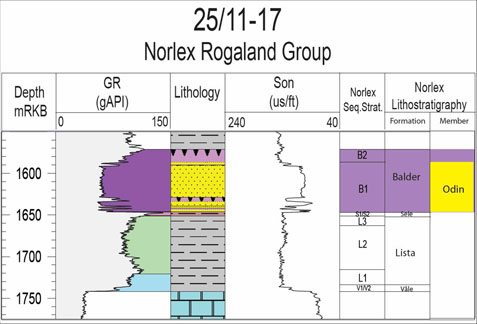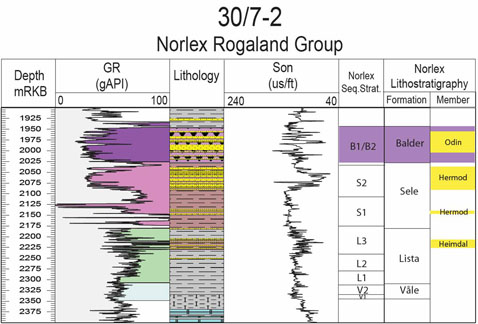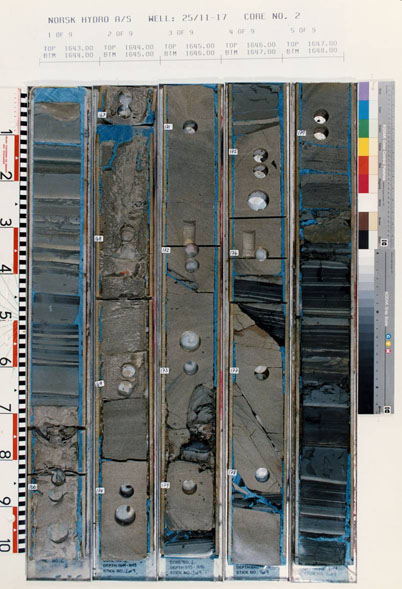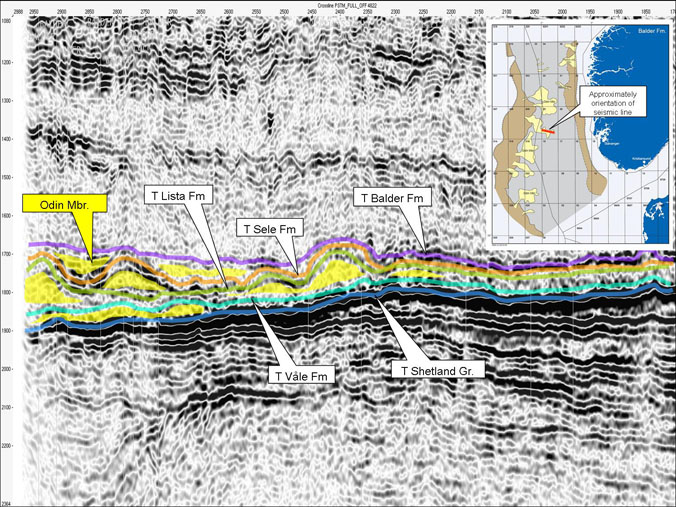Odin Member
updated to follow: Stratigraphic Guide to the Rogaland Group, Norwegian North Sea. Harald Brunstad, Felix M. Gradstein, Jan Erik Lie, Øyvind Hammer, Dirk Munsterman, Gabi Ogg, and Michelle Hollerbach. Newsletter on Stratigraphy, vol 46/2 pp137-286, 2013.
Rogaland Group, Balder Formation
Unit definition
The Odin Member is attributed to the Intra Balder Formation sandstones in Subarea NW
in Figs. 1.
 Fig 1: Location map of the Members of the Balder Formation.
Fig 1: Location map of the Members of the Balder Formation. |
Name
The name Odin Member was proposed for sandstones in the Balder Formation by Mudge &
Copestake 1992. The Odin member is age and lateral equivalent to the shallow to slope
marine sandstones of the Dornoch Member further to the west.
Derivatio nominis
The Member is named after the Norse God Odin.
Type well
UK well 9/18a-15. Depth 1676-1875 mRKB. Coordinates N 59°26'36.670",
E 01°33'20.080" (coordinates of 9/18a-4).
Reference wells
Norwegian well 25/7-17 (Fig. 133)
. Depth 1587-1647 mRKB. Coordinates N 59°03'26.66", E 02°29'06.59". Cores:
Core 1 and 2.
Norwegian Well 30/7-2 (Fig. 134)
. Depth 1955-2004 mRKB. Coordinates N 60°29'26.06", E 02°01'40.85".
Cores: Cores 7 and 8.

Fig. 133. Well 25/11-17 Composite log Rogaland Group. Stratigraphic position of the
Odin Member is outlined in stratigraphic column to the right.
|

Fig. 134. Well 30/7-2 Composite log Rogaland Group. Stratigraphic position of the
Odin Member is outlined in stratigraphic column to the right.
|
Composition
The sandstones are well to moderately sorted, clean and poorly cemented, although
tightly cemented sandstones occur locally. Grains are medium rounded to sub angular.
A core example from the Odin Member is shown in Fig. 135.
Sandstone intrusions are
frequently found associated with the upper boundary of sandstones bodies, often with
an abundance of angular and tabular mudstone clasts.

Fig. 135. Core photo from lower parts of the Odin Member in well 25/11-17. Sediments
are
interpreted as high density turbidites influenced by secondary water escape and sand
mobilization. Note striped appearance of bedded shale. Darker lamina represent normal
anoxic shales, whereas lighter lamina/thin beds represent tuffs. Well drilled by Norsk
Hydro. Photo from NPD Fact Pages at http://www.npd.no.
|
Wireline log characterization
The sandstones of the Odin Member often have a blocky appearance, but also serrated
log pattern or fining/coarsening upwards patterns can be seen in some wells. Sometimes
the Odin Member can be difficult to distinguish from gamma-ray and sonic logs, since
the surrounding tuffaceous Balder Formation has relatively
low gamma-ray readings and
high velocity. In such cases resistivity and porosity/density logs can be useful.
Upper boundary (revised)
The Odin Member is overlain by the Balder Formation with
variable amounts of tuff. The
transition from the Balder Formation is usually seen as a downwards decrease from
low/intermediate gamma-ray readings to lower gamma-ray readings together with an
increase in velocity readings.
Lower boundary (revised)
The basal contact of the Odin Member is seen as the boundary between shales of the
Sele or Balder Formation and the lower parts of the Odin
Member. The boundary is
placed where there is an upwards transition from higher gamma-ray readings and higher
velocity in the shales to lower gamma-ray readings and higher velocity in the
sandstones.
Thickness
Sandstone units up to 200 m thick, belonging to the Odin Member, occur in central
and northern parts of the Viking Graben (Knox & Holloway, 1992).
Seismic characterization
The seismic character of the Odin Member varies from mounded to lenticular or trough
shaped channel infills. Sometimes the top of the sandstones of the Odin Member is
associated with a marked change in acoustic impedance and an increased amplitude
(Fig. 130 rightmost parts)
. In other cases the top of the Odin Member is difficult to
recognize, and its presence is inferred from a thickening of the Balder Formation
interval
(central left in Fig. 136)
.

Fig. 136. WE seismic cross section through area between Northern Balder and Grane
discoveries, Blocks 25/10 and 25/11. Inferred presence of the Odin Member is
highlighted.
|
Age
Earliest Eocene (Early Ypresian).
Biostratigraphy
Being contained in the Balder Formation, the age of the Odin Member is bounded by
biostratigraphy and age assignments for the Balder Formation. See description for the
Balder Formation.
Correlation and subdivision
The Balder Formation, which contains the Odin Member, is divided into a lower very
tuffaceous unit (B1) and an upper less tuffaceous unit (B2). Sandstones of the Odin
Member mostly belong to the B1 unit of the Balder formation (Odin B1 sandstones), but
sandstones are also found in the B2 unit (Odin B2 sandstones).
Geographic distribution
In the Norwegian sector, the Odin Member is mostly restricted to the Viking Graben,
but it is also found locally at the Utsira High, as for example in the Balder Field
(Fig. 1 and Fig. 132)
, and in well 25/11-17, east on the Utsira high.
Depositional environment
The Odin sandstones are mostly interpreted as representing mass flow transport and
deposition in channels or fans sourced from shallow marine environments of the East
Shetland Platform. Some sandstones are considered to have been emplaced by injection
from lower levels.
Discoveries with the Odin Member as reservoir
- Balder Field. Part of reservoir complex. Oil discovery.


 Fig 1: Location map of the Members of the Balder Formation.
Fig 1: Location map of the Members of the Balder Formation.


